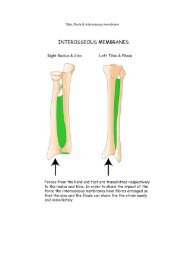GSM 11.11 version 6.2.0 - TTFN Smart card pages
GSM 11.11 version 6.2.0 - TTFN Smart card pages
GSM 11.11 version 6.2.0 - TTFN Smart card pages
- No tags were found...
You also want an ePaper? Increase the reach of your titles
YUMPU automatically turns print PDFs into web optimized ePapers that Google loves.
(<strong>GSM</strong> <strong>11.11</strong> <strong>version</strong> <strong>6.2.0</strong> Release 1997)16TS 100 977 V<strong>6.2.0</strong> (1999-05)- The high current options of ISO/IEC 7816-3 [26] for V IH and V OH are not specified for the SIM as they apply toNMOS technology requirements. No realization of the SIM using NMOS is foreseen.5.1 Supply voltage Vcc (contact C1)The SIM shall be operated within the following limits:Table 1: Electrical characteristics of Vcc under normal operating conditionsSymbol Minimum Maximum UnitVcc 4,5 5,5 VIcc 10 mAThe current consumption of the SIM shall not exceed the value given in table 1 during any state (including activationand deactivation as defined in subclause 4.3.2).When the SIM is in idle state (see below) the current consumption of the <strong>card</strong> shall not exceed 200 µA at 1 MHz and25°C. If clock stop mode is allowed, then the current consumption shall also not exceed 200 µA while the clock isstopped.The ME shall source the maximum current requirements defined above. It shall also be able to counteract spikes in thecurrent consumption of the <strong>card</strong> up to a maximum charge of 40 nAs with no more than 400 ns duration and an amplitudeof at most 200 mA, ensuring that the supply voltage stays in the specified range.NOTE:A possible solution would be to place a capacitor (e.g. 100 nF, ceramic) as close as possible to thecontacting elements.5.2 Reset (RST) (contact C2)The ME shall operate the SIM within the following limits:Table 2: Electrical characteristics of RST under normal operating conditionsSymbol Conditions Minimum MaximumV OH I OHmax = +20 µA Vcc-0,7 Vcc (note)V OL I OLmax = -200 µA 0V (note) 0,6 Vt R t F C out = C in = 30 pF 400 µsNOTE:To allow for overshoot the voltage on RST shall remain between-0,3 V and Vcc+0,3 V during dynamic operation.5.3 Programming voltage Vpp (contact C6)SIMs shall not require any programming voltage on Vpp. The ME need not provide contact C6. If the ME providescontact C6, then, in the case of the ID-1 SIM the same voltage shall be supplied on Vpp as on Vcc, while in the case ofPlug-in SIMs the ME need not provide any voltage on C6. Contact C6 may be connected to Vcc in any ME but shall notbe connected to ground.5.4 Clock CLK (contact C3)The SIM shall support 1 to 5 MHz. The clock shall be supplied by the ME. No "internal clock" SIMs shall be used.If a frequency of 13/4 MHz is needed by the SIM to run the authentication procedure in the allotted time (see<strong>GSM</strong> 03.20 [11]), or to process an ENVELOPE command used for SIM Data Download, bit 2 of byte 1 in the filecharacteristics shall be set to 1. Otherwise a minimum frequency of 13/8 MHz may be used.ETSI








